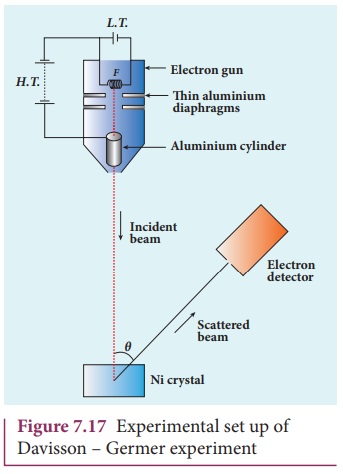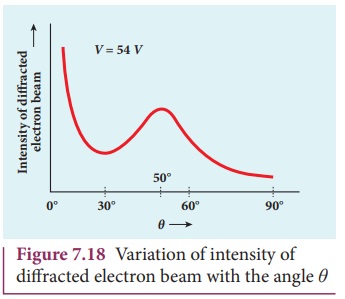Wave nature of particles | Physics - Davisson - Germer experiment | 12th Physics : UNIT 8 : Dual Nature of Radiation and Matter
Chapter: 12th Physics : UNIT 8 : Dual Nature of Radiation and Matter
Davisson - Germer experiment
Davisson - Germer experiment
De Broglie hypothesis of matter
waves was experimentally confirmed by Clinton Davisson and Lester Germer in
1927. They demonstrated that electron beams are diffracted when they fall on
crystalline solids. Since crystal can act as a three-dimensional diffraction
grating for matter waves, the electron waves incident on crystals are
diffracted off in certain specific directions. Figure 7.17 shows a schematic
representation of the apparatus for the experiment.

The filament F is heated by a low tension (L.T.) battery. Electrons are emitted from the hot filament by thermionic emission. They are then accelerated due to the potential difference between the filament and the anode aluminium cylinder by a high tension (H.T.) battery. Electron beam is collimated by using two thin aluminium diaphragms and is allowed to strike a single crystal of Nickel.
The electrons scattered by Ni atoms
in different directions are received by the electron detector which measures the
intensity of scattered electron beam. The detector is rotatable in the plane of
the paper so that the angle Ď• between the incident beam and the scattered beam can be changed
at our will. The intensity of the scattered electron beam is measured as a
function of the angle θ.

It is to be noted that electrons are
not the only particles with which wave nature
can be demonstrated. The particles like neutrons and alpha particle are
also associated with waves. They undergo diffraction when they are scattered by
suitable crystals. Neutron diffraction studies are highly useful for
investigating crystal structures.
Diffraction is one of the properties
of waves. Whenever waves are incident on an obstacle, they bend around the
edges of the obstacle. This bending of waves is called diffraction. The amount
of bending depends on the wavelength of the waves.
We have learnt in unit 6 that as the
wavelength of light is very small, diffraction effects of light are very small.
In order to study diffraction of light, diffraction gratings are used.
Since X-rays and de Broglie waves of
electrons have wavelengths (in the order of 10–10m) much shorter than that of
the light wave, diffraction grating cannot be used for their diffraction. In a
crystal, the spacing between atomic planes is comparable to the wavelength of
x-rays and de Broglie waves of electrons. Hence, for their diffraction, the
crystals are used which serve as three-dimensional grating.
Figure 7.18 shows the variation of
intensity of the scattered electrons with the angle θ for the accelerating voltage of 54V. For a given accelerating voltage V, the scattered wave shows a peak or maximum at an angle of 50° to
the incident electron beam. This peak in intensity is attributed to the
constructive interference of electrons diffracted from various atomic layers of
the target material. From the known value of interplanar spacing of Nickel, the
wavelength of the electron wave has been experimentally calculated as 1.65Ă….
The wavelength can also be
calculated from de Broglie relation for V
= 54 V from equation (7.18) as

This value agrees well with the
experimentally observed wavelength of 1.65Ă….
Thus this experiment directly verifies de Broglie’s hypothesis of the wave
nature of moving particles.
Related Topics